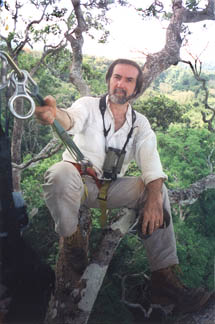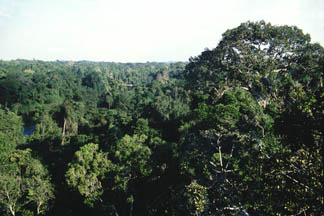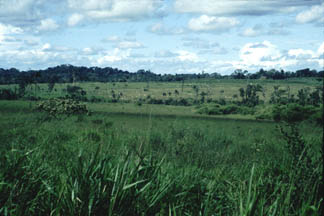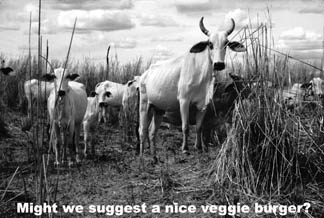
My 50th birthday in the treetops. Photo by Teresa Wood
A Birthday in the Treetops
by Paul Donahue
February 2003
I made my first trip to South America in 1972 and have been lucky enough to be able to spend a significant portion of most years since then working at some place or other in South America. By far, the majority of that time has been spent in the Amazon Basin, first in the western portion of the basin in eastern Peru, and, more recently, in the southern Amazon of Brazil. The Amazon rainforest is an area where I have come to feel as comfortable as I do in the woods of Maine.

My 50th birthday in the treetops. Photo by Teresa Wood
For the past 15 years, much of the time my wife and I have spent in the Amazon has been spent climbing large trees and working in the forest canopy. We have built dozens of canopy observation platforms, constructed two canopy walkways, of 450 meters and 250 meters length, and taken literally thousands of people up into the forest canopy on ropes. I have spent many birthdays in the wilds of the Peruvian Amazon, and this past July I spent my 50th birthday in the Brazilian Amazon. It was a big day for me, and to mark (not celebrate) the day, I had decided to climb a new tree - just to make the point to myself that I could still do it. I had chosen the tree a couple of weeks earlier because it looked particularly tall and like it would provide a good view of the nearby Rio Cristalino.
I had anticipated that the tree would be a fairly straightforward climb, however, I was wrong. The climbing was difficult at first because of the great girth of the tree, but got easier as I went up and the trunk gradually narrowed. Then, before even reaching the first fork at around 70 feet, I ran into a tangled, spiny liana (heavy woody vine) wrapped around the trunk. Somehow I had missed it when checking out the tree from below. Grabbing at my clothing and climbing gear and ripping at my exposed skin, it seriously impeded my upward progress until I took out my pocket knife and did a bit of pruning.
Leaving the liana behind and continuing upward, I soon noticed that large yellowish sweat bees were becoming particularly numerous, and I began looking all around for a nest.
Sweat bees are a large group of stingless bees in the family Apidae, subfamily Meliponinae. They do not sting, but larger species do have a nasty bite, and they aggressively defend their large nests from intruders - like canopy biologists. They are called sweat bees because they are attracted to perspiration. Unfortunately, they are abundant in the Amazon rainforest canopy. Climbing trees is sweaty work, so sweat bees are almost always around. Along with biting ants, they are one of the true curses of canopy work
I was not able to spot a nest, so continued upward. However, shortly after reaching the first fork, I spotted the bees' nest and the bees found me, attacking en masse. Luckily, I had my headnet with me (always carried for just such emergencies) and quickly donned it. The sweat bees were of the “corta pelo” variety - "hair cutter" bees that quickly burrow into the base of your hair and begin snipping it out in chunks. They did their best to get in under my headnet, with some succeeding. Others contented themselves with biting my bare hands and arms, or climbing in through the neck of my shirt.
I hung there for a moment, seriously considering a retreat back down to earth, and had it not been my birthday, I probably would have gone down. But it was my 50th birthday and I had a point to make to myself, and I decided I would be damned if I was going to let a few bees keep me from my goal. So, I continued climbing on up in spite of them, taking their bites.
About the time I began to leave the bees behind, I climbed up into another mass of the same spiny liana. The vine was dense enough at that point that it was holding me back, grabbing at my back and ripping my shirt, as well as tearing at my hands. To climb higher required some more painstaking trimming with my knife, and took a toll in blood and cloth.
Finally, I reached my target fork high in the crown of the tree, well above the tops of the nearby trees. The view was as good as I had hoped, with a spectacular panorama of forest and "serras" (isolated low hills rising steeply out of the forest) spread out behind the cataracts of the Rio Cristalino below me. I felt extremely fortunate. After all, how many North Americans have had the privilege of spending their 50th birthday perched on a limb of a jungle tree in Brazil, 121 feet above the forest floor, looking out over a landscape of pristine Amazonian forest?

The view from my treetop perch along the Rio Cristalino in northern Mato Grosso, Brazil. Photo by Paul Donahue.
As beautiful as the scene was, however, all was not well in Paradise. From my high perch I was fortunately not quite high enough to see the distant ridges that have been cleared for cattle pasture, but I was high enough to see rising smoke on the horizon, the sign of the “burning season” in the Brazilian Amazon. I was overtaken by waves of sadness when I thought about a baby born that day. What if that child grew up to be a naturalist, as I had? On their 50th birthday, what was the likelihood that they too would be able to climb into the treetops of the Amazon rainforest and look out over an unbroken forest canopy?
Regrettably, the chances of that being a possibility are very slim, indeed. As sad as it is, the great Amazon rainforest is steadily being chopped down and burned. The magical rainforest I have come to love is being destroyed before my eyes.
For twenty-five years we have heard the cries from environmentalists warning that the rainforest and its tremendous bounty of biodiversity is disappearing. After endless campaigns, the formation of countless new rainforest conservation groups, partnerships between local and international conservation groups, public education projects, nature shows on television, appeals for funds, posters, calendars, t-shirts, children's' books, reports in newsletters, magazine articles, scientific articles, speeches, visits from the leaders of indigenous Amazon tribes, and expert testimony before bodies like the World Bank, the net result is that the Amazon rainforest is being cut down as fast as ever - maybe even faster. As environmentalists, either we are doing the wrong thing, or we are not doing nearly enough.
In 2001, the latest year for which there are figures, logging and fires destroyed 6,315 square miles of the Amazon rainforest. The causes of this continuing destruction are many, and basically the same as they have always been….logging, mining, oil exploration, dam projects, subsistence farming, export agribusiness, tree plantations, and road-building.
Much of the deforestation is done to create pasture to feed one of the fastest growing cattle herds in the world. In the nine Brazilian states that comprise the "Legal Amazon" there were over 47 million head of cattle in the year 2000, 80% higher than in 1990 and greater than the combined total cattle herds of Canada and Australia. The expansion of cattle ranching is occurring at such a rapid pace that concerned analysts have felt the need to coin a new term, "pecuarização" (cattlelization). The problem is greatly compounded by the fact that a high proportion of the pastures being created are based on unsustainable management practices. The result is pasture degradation, which compels ranchers to clear additional forests to maintain their herd
.

Cattle pasture on land once covered with rainforest, south of the Rio Teles Pires in northern Mato Grosso, Brazil. Photo by Paul Donahue.
In the southern Amazon state of Mato Grosso where we are now working, "cattlelization" is clearly the main cause of deforestation. The forest is first cut down, then the vegetation is burned off. By June of 2002 Mato Grosso had already seen 10,000 fires since January. More than half the Amazon rain forest is being damaged by air pollution from these fires. One of the problems is that the burning forests are generating so much smoke and soot that they are actually blocking sunlight in some areas. On many days the smoke is so thick that the sun is turned orangish and the sky grayish. In addition, burning the vegetation produces gases, which combined with sunlight, create ground-level ozone, a pollutant that harms plant life and can drift long distances.
A large percentage of the beef that Brazil produces is exported - about 800,000 tons in 2002 - making Brazil the world's third largest exporter of beef. Much of it is bound for the US, which is far and away the world's largest beef consumer and beef importer. Total U.S. beef imports were forecast to reach 1.47 million tons in 2002, up nearly 3 percent from the record 1.43 million tons imported in 2001.
In a very direct way, our tremendous appetite for beef in this country is driving environmental degradation, in general, and Amazonian deforestation, in particular. The example that is frequently given is that it takes 55 square feet of rainforest land just to produce one quarter-pound fast-food hamburger (how many billion hamburgers has MacDonald's sold?). Much of the imported Brazilian beef also comes in the form of canned beef products - corned beef, beef stews, beef soups, and so on. But whatever form it comes in, beef is an environmental disaster. Even eating US-grown beef wreaks havoc on the Brazilian environment as vast areas of the country are now being converted to soybean production to feed US cattle (not to mention the tremendous environmental damage cattle production causes in this country).

Brahma cattle on degraded pasture land in Brazil. Photo by Paul Donahue.
What we choose to eat is one of the most significant environmental decisions we make. If we care about the future of the Amazonian rainforest, as well as the rest of the planet, we need to eliminate beef from our diet. It is that simple. As individuals, it is one of the most important steps we can take.
After coming down from my treetop lookout earlier in the day, I decided to spend the sunset of my 50th birthday overlooking the rainforest from the top level of the165 foot high canopy tower. From this higher vantage point there was no denying of reality. The view from the canopy tower is magnificent, with many square miles of pristine forest spreading out in all directions, broken only by the Rio Cristalino and the occasional "serras". But on the most distant ridges, bluish in the haze, is the sign of the future for the Brazilian Amazon - extensive deforestation for cattle pasture. While from my treetop perch I could only see bits of smoke, from the higher perspective of the canopy tower the smoke could be seen to be a wide dirty brownish band stretching across the sky from horizon to horizon, having drifted up over the forest from the deforested areas to the south. As the sun set on my first half century, I watched in sadness as the forest I love slowly drifted by as a sooty smudge in the sky.